Birrer (2014) reports, on the basis of the TV-report “More underage criminal tourists” by Georg Humbel (2014), about the allegedly increasing number of criminal Rroma children. As the article by Gut/Scherrer (2013) in the Weltwoche of November 2013, Birrer cites police sources that speak of transnationally operating child-trafficking networks. The basic existence of such criminal actors is not to deny here, but their characterisation and especially their frequency, has to be strongly questioned. Birrer argues as follows, in reference to the Bernese immigration-policemen Alexander Ott: “They come mainly from Eastern Europe – and don’t pursue their criminal activity voluntarily in Switzerland. In their home countries, they are recruited by traffickers, and finally borrowed from well-organized gangs. Many of them are Roma from Romania and Bulgaria. […] The children are under constant scrutiny of agile backers. They have to expect sanctions, if they do not generate a certain amount of cash and valuables. Therefore, they are helplessly extradited to the traffickers.” The evidence for the existence of such child-trafficker gang is very poor, as many articles to show (compare Friedli/Schöpfer 2013, Mappes-Niediek 2012, Mappes-Niediek 2013, Jirat 2013, Tabin 2012). Rather, they are civil and police morals and assumptions associated with them that make the begging or stealing children automatically victims of brutal traffickers. The fact that behind it, there is mostly great poverty which forces to beg is not considered in this reasoning. Thus gaps in knowledge, about the socio-economic situation in the countries of origin of the children are used in order to present them as part of criminal Rroma gangs. This practice says more about the own prejudices and morals, than it explain something about the Rroma.
Jirat (2013) discusses the project „Agora“, which was founded on the initiative of Alexander Ott in 2009. The aim of this project is to prevent organized child abuse and human trafficking, of which young Rroma are said to be mainly affected. Jirat questions precisely this status of the beggars. The data of the Bernese immigration police – which states a strong presence of beggar gangs in Bern – are of doubtful origin. Jirat states: “The immigration police view is necessarily limited: the focus is always a possible crime (human trafficking or child abuse), and there are always potential perpetrators, which are repeatedly named: “most of them are Roma.” This is the crucial point. “Through this representation, the social construction of a ‘Roma-problem’ in connection with begging is made”, says the historian Bernhard Schär from the Center for Democracy in Aarau. The same is done in connection with break-ins or street prostitution.” The perspective and analysis of the immigration police, Jirat argues, is a strongly biased. It operates with the logic of perpetrators and victims. The sociological perspective is almost totally neglected.
Tabin (2012) proves that a causal relationship between begging children and organized gangs cannot be confirmed by social science. The modest incomes obtained by begging, don’t coincide in any way with the proceeds referred to by the Bernese immigration police, which speaks of up to 600 francs per child. Tabin, who refers to additional, similar studies, comes to an average amount of 15 to 20 francs per day.
In any case, it is very problematic to describe the begging of Rroma children as a cultural phenomenon. Journalists as Mappes-Niediek decidedly write against this notion and see the supposed beggar gangs in reality as a symptom of poverty, that has nothing to do with organized crime: “There are prestige hierarchies in the Roma neighbourhoods, customary clientilism, dependencies, mostly through informal money lending. But structures of command and obedience were not noticed by the numerous social workers, anthropologists or humanitarian aid workers, who work in Roma slums and sometimes live there. [ … ] Wrong is also the impression that human trafficking, crime and begging with children is the rule among the poverty migrants from Bulgaria and Romania. Begging with kids is prohibited all over Europe and basically rarely, because it takes place, by its very nature, in the greatest possible publicness” (Mappes-Niediek 2013).
- Birrer, Raphaela (2014) Wie die Bettelkinder aus Bern verschwanden. In: Tages-Anzeiger online vom 10.4.2014. http://www.tagesanzeiger.ch/schweiz/standard/Wie-die-Bettelkinder-aus-Bern-verschwanden/story/20409948
- Friedli, Corina/Schüpfer, Linus (2013) „Es bräuchte viele Polizisten und teure Gefängnisse“ In: Tages Anzeiger online vom 25.1.2013. http://www.tagesanzeiger.newsnet.ch/kultur/diverses/Es-braeuchte-viele-Polizisten-und-teure-Gefaengnisse/story/23853760?track
- Gut, Philipp/Scherrer, Lucien (2013) Geschäftsmodell: Kinderhandel. In: Die Weltwoche Nr. 44: 2013, S. 20-22.
- Humbel, Georg (2014) Mehr minderjährige Kriminaltouristen. In: Schweizer Radio und Fernsehen online vom 9.4.2014. http://www.srf.ch/news/schweiz/mehr-minderjaehrige-kriminaltouristen
- Jirat, Jan (2013) Der dominante Blick der Fremdenpolizei. In: Die Wochenzeitung (WOZ) online vom 15.8.2013. http://www.woz.ch/1333/roma-in-der-schweiz/der-dominante-blick-der-fremdenpolizei
- Mappes-Niediek, Norbert (2012) Arme Roma, böse Zigeuner. Berlin: Christoph Links Verlag.
- Mappes-Niediek, Norbert (2013) Falsche Könige. In: TAZ online vom 4.3.2013. http://www.taz.de/!112116/
- Tabin, Jean Pierre et al. (2012) Rapport sur la mendicité « rrom » avec ou sans enfant(s). Université de Lausanne. http://www.oprerrom.org/pdf/Mendicité_Rrom_Rapport_final_2012_EESP_UNIL.pdf







